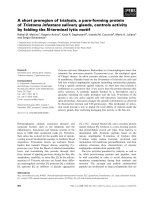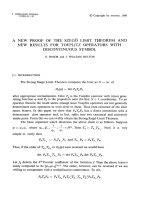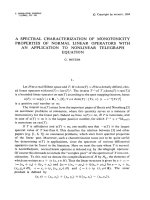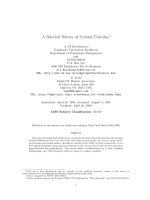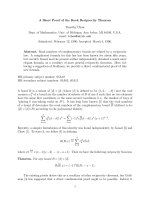Báo cáo toán học: "A Short Proof of the Rook Reciprocity" pps
Bạn đang xem bản rút gọn của tài liệu. Xem và tải ngay bản đầy đủ của tài liệu tại đây (57.77 KB, 2 trang )
A Short Proof of the Rook Reciprocity Theorem
Timothy Chow
Dept. of Mathematics, Univ. of Michigan, Ann Arbor, MI 48109, U.S.A.
email:
Submitted: February 12, 1996; Accepted: March 4, 1996.
Abstract. Rook numbers of complementary boards are related by a reciprocity
law. A complicated formula for this law has been known for about fifty years,
but recently Gessel and the present author independently obtained a much more
elegant formula, as a corollary of more general reciprocity theorems. Here, fol-
lowing a suggestion of Goldman, we provide a direct combinatorial proof of this
new formula.
MR primary subject number: 05A19
MR secondary subject numbers: 05A05, 05A15
A board B is a subset of [d] × [d](where[d]isdefinedtobe{1, 2, ,d})andtherook
numbers r
B
k
of a board are the number of subsets of B of size k such that no two elements
have the same first coordinate or the same second coordinate (i.e., the number of ways of
“placing k non-taking rooks on B”). It has long been known [5] that the rook numbers
of a board B determine the rook numbers of the complementary board B (defined to be
([d] × [d])\B) according to the polynomial identity
d
k=0
r
B
k
(d − k)! x
k
=
d
k=0
(−1)
k
r
B
k
(d − k)! x
k
(x +1)
d−k
.
Recently, a simpler formulation of this identity was found independently by Gessel [2] and
Chow [1]. To state it, we follow [4] in defining
R(B; x)
def
=
d
k=0
r
B
k
x
d−k
,
where x
n
def
= x(x−1)(x−2) ···(x−n+1). Then we have the following reciprocity theorem.
Theorem. For any board B ⊂ [d] × [d],
R(B; x)=(−1)
d
R(B; − x − 1).
The existing proofs derive this as a corollary of other reciprocity theorems, but Gold-
man [3] has suggested that a direct combinatorial proof ought to be possible. Indeed, it
1
is, and the purpose of this note is to provide such a proof. The knowledgeable reader will
recognize that the main idea is borrowed from [4].
Proof. Observe that
(−1)
d
R(B; − x − 1) = (−1)
d
d
k=0
r
B
k
( − x − 1)
d−k
=
d
k=0
(−1)
k
r
B
k
(x + d − k)
d−k
.
First assume x is a positive integer. Add x extra rows to [d] × [d]. Then r
B
k
(x + d − k)
d−k
is the number of ways of first placing k rooks on B and then placing d − k more rooks
anywhere (i.e., on B, B or on the extra rows) such that no two rooks can take each other
in the final configuration. By inclusion-exclusion, we see that the resulting configurations
in which the set S of rooks on B is nonempty cancel out of the above sum, because they
are counted once for each subset of S, with alternating signs. Thus what survives is the
set of placements of d non-taking rooks on the extended board such that no rook lies on B.
But it is clear that this is precisely what R(B; x) enumerates. Therefore the theorem holds
for all positive integers x and since it is a polynomial equation it holds for all x.
Acknowledgments
This work was supported in part by a National Science Foundation Graduate Fellowship
and a National Science Foundation Postdoctoral Fellowship.
References
[1] T. Chow, The path-cycle symmetric function of a digraph, Advances in Math., in
press.
[2] I. M. Gessel, personal communication.
[3] J. R. Goldman, personal communication.
[4] J. R. Goldman, J. T. Joichi, and D. E. White, Rook theory I. Rook equivalence of
Ferrers boards, Proc. Amer. Math. Soc. 52 (1975), 485–492.
[5] J. Riordan, “An Introduction to Combinatorial Analysis,” Wiley, New York, 1958.
2
